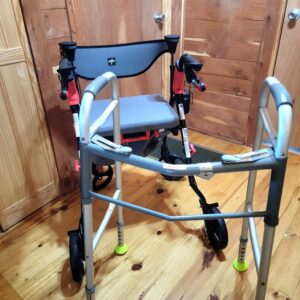
My husband suffers from post-polio syndrome. Contracting polio just months before the vaccine came out left him with weakened shoulders and one atrophied leg. The polio symptoms have returned, leaving him dependent a walker and with diminished upper body strength. The disease has progressed with age. He additionally owns a motorized scooter so we can enjoy sightseeing together.
The Americans With Disabilities Act of 1990 decreed that:
II-4.4100 General. Public accommodations must remove architectural barriers and communication barriers that are structural in nature in existing facilities, when it is readily achievable to do so.
What is an architectural barrier? Architectural barriers are physical elements of a facility that impede access by people with disabilities. These barriers include more than obvious impediments such as steps and curbs that prevent access by people who use wheelchairs.
In many facilities, telephones, drinking fountains, mirrors, and paper towel dispensers are mounted at a height that makes them inaccessible to people using wheelchairs. Conventional doorknobs and operating controls may impede access by people who have limited manual dexterity. Deep pile carpeting on floors and unpaved exterior ground surfaces often are a barrier to access by people who use wheelchairs and people who use other mobility aids, such as crutches. Impediments caused by the location of temporary or movable structures, such as furniture, equipment, and display racks, are also considered architectural barriers.
NOT LIVING UP TO A PROMISE 32 YEARS LATER
Where are we thirty-two years later? Not nearly far enough. While the curb cuts and ramps were satisfactory, here’s what we ran into:
- Limited disabled parking at some facilities.
- Several had available parking spots far away from the handicapped accessible entrance. One had disabled parking next to an inaccessible entrance, requiring us to walk around to the front of the building just to get in. Try that on a walker.
- Bathrooms, even in places whose exterior doors were accessible, were a nightmare. Most had heavy doors that my husband could not open. (I assisted, but it made me a bit nervous holding open the door to the men’s room.) In frustration, we began to use the family bathroom (when available) so I could assist.
The bottom line is that my husband could not have made the trip by himself—too many barriers exist to this day.
WHAT’S STOPPING US FROM NOT LIVING UP TO A PROMISE?
The two simple words “readily achievable” have slowed our progress.
According to the ADA Technical Assistance Manual, determining if barrier removal is readily achievable is necessarily a case-by-case judgment. Factors to consider include:
1) The nature and cost of the action;
2) The overall financial resources of the site or sites involved; the number of persons employed at the site; the effect on expenses and resources; legitimate safety requirements necessary for safe operation, including crime prevention measures; or any other impact of the action on the operation of the site;
3) The geographic separateness, and the administrative or fiscal relationship of the site or sites in question to any parent corporation or entity;
4) If applicable, the overall financial resources of any parent corporation or entity; the overall size of the parent corporation or entity with respect to the number of its employees; the number, type, and location of its facilities; and
5) If applicable, the type of operation or operations of any parent corporation or entity, including the composition, structure, and functions of the workforce of the parent corporation or entity.
Things only get fixed when people complain and even then, change is slow. No one wants to spend the money. Personally, I think people just don’t care. Disabled people are invisible people.
In the past year, I have made two complaints regarding inaccessibility, one to the Texas Department of Public Safety whose driver’s license office near me had heavy doors that my husband could not manually open and another to a nonprofit event that held parts of a fundraiser in an inaccessible building.
We can do better. We must do better. Living up to a promise is everyone’s responsibility.
Sign up on www.mariewatts.com to receive future Stories About Life delivered to your email address or read more stories by clicking here.

Recent Comments